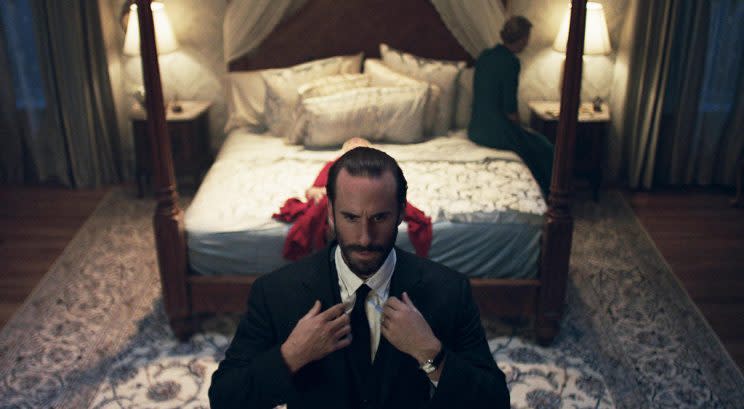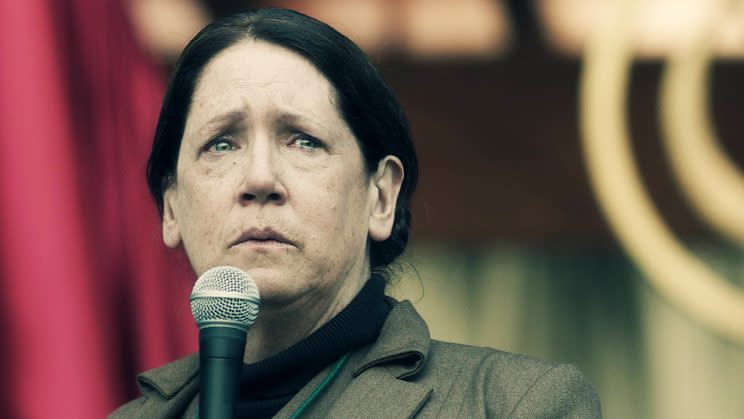‘The Handmaid’s Tale’ Postmortem: Elisabeth Moss on That Breeding Scene and Offred’s Real Name

Warning: This post contains spoilers for the first episode of The Handmaid’s Tale, “Offred.”
The first episode of The Handmaid’s Tale has two important — and, in some ways, competing — goals. On the one hand, it has to reassure admirers of Margaret Atwood’s singular 1985 novel that it’s going to preserve the chilling horror of the world the Canadian author described on the page: a near-future (or possibly even present-day) theocratic society established by patriarchal founders who insist they’re using biblical precedents to strip women of their rights.
At the same time, the series premiere also has to expand the show’s scope beyond the limited point of view of the novel’s narrator, Offred (Elisabeth Moss), one of the red-cloaked women who have been forced into service as breeders for an increasingly infertile population. More genteelly described as a “Handmaid,” Offred has recently taken up residence in the home of Fred and Serena Joy Waterford (Joseph Fiennes and Yvonne Strahovski), a childless couple who hope that her womb will be the answer to their prayers.
An early example of how the premiere’s twin goals meet in the middle, so to speak, comes when Offred and the Waterfords engage in a ritual that’s become the norm in this alternate United States of America, rechristened as the Republic of Gilead: a breeding ceremony. Shot for shot, the sequence we see onscreen re-creates the bizarre scene that Atwood describes in the book: A fully-clothed Offred lies between Serena Joy’s spread-eagle legs, while Fred stands at the foot of the bed thrusting into her. Any hint of sexuality is drained from the proceedings: It’s a mechanical act intended purely for procreation, and Serena Joy’s presence is meant to alleviate any hint of adultery. “It has to be extremely clinical,” Moss told Yahoo TV about this key sequence in both the book and the series. “It’s a cross between a breeding and a sexual assault.” (Watch our video interview above.)

Under the direction of Reed Moreno, who helmed the first three episodes of The Handmaid’s Tale, which debuted on Hulu on April 26, this scene also unlocks other perspectives beyond Offred’s. In the book, she wonders how Serena Joy feels about being part of this ceremony. In the series, we, the audience, don’t have to wonder — it’s written all over Strahovski’s face. “This scene speaks to what she’s lost,” the Australian actress says. “She can no longer relate to [Fred] sexually, and now she has to watch him be sexual with another woman in order to produce a child. There’s a lot of confusing things going on here.”
Expect the world of The Handmaid’s Tale to continue expanding outward as the episodes progress, as the series ventures off-book to pursue different characters and storytelling avenues. So far, though, many of these changes are rooted in Atwood’s words, even when the show’s interpretation of those words may not be what the author intended. Take the final line of the premiere, when Offred reveals her pre-Gilead name by telling us in defiant voiceover: “My name is June.” Over the years, that’s an identity that readers have assigned to the tale’s unnamed narrator, despite Atwood steadfastly declining to confirm that theory.
In a separate interview, Moss talked about how important it was for her performance to know that her character had a name, an identity, and a family before the identity of Offred was forced on her. “I always use her real name,” she says emphatically. “Whenever I write anything down in emails about the character, I always use June. And when talking to the directors, I always use June, unless I’m talking about a specific scene where she has to be Offred. It’s very important for me to keep reminding myself that she’s a modern woman and a real person. She’s not this label they’ve put on her.”

Moss values June’s name so highly, she took three passes at recording the premiere’s final line until she was satisfied with it. Funnily enough, though, they wound up using the first take anyway. “There was something about that first recording that was very emotional. You can hear it in my voice, and Reed, Bruce [Miller, the show’s executive producer], and myself were all tearing up. With other lines, we shifted it around and made it better. But in this case we were like, ‘It’s not as good as the original.'”
While voiceover can too often become a dramatic crutch, in the case of The Handmaid’s Tale it feels vital. After all, the voice that’s running in Offred’s head is her true voice — the one silenced by the oppressive male army that remade America as Gilead. Since June is actively discouraged from speaking in public, she reasserts herself in all her anger and dark humor behind Offred’s stoic gaze. As Moss points out, the voiceover also allows the writers to retain Atwood’s language from the novel, instead of having to translate that rich, heady prose into realistic dialogue.
“Initially, we would record all of the voiceover before I shot an episode,” Moss says. “But it became very apparent very quickly that was a mistake. So from the second episode on, I would be sent the episode, watch it, and then record the voiceover. Part of the reason was to make sure the voiceover just felt like a cherry on top — that you’d be able to watch the show without it and still understand what’s happening. I think that’s what people generally mean when they say, ‘Don’t use voiceover.'”
June’s running narration pointedly fades away in the premiere’s most violent moment, when the assembled Handmaids — including Offred’s quasi-friend, Ofglen (Alexis Bledel), are presented with a man their instructor, Aunt Lydia (Ann Dowd), tells them is guilty of rape. His fate, Lydia implies, is left in their hands. A similar sequence appears late in the novel, and Ofglen leads the Handmaid charge in beating the accused man to death. In the show, though, Offred is the one who delivers the first blow, overcome by memories of her missing friend, Moira (Samira Wiley).

“She thinks Moira is dead, so she lashes out,” Moss explains. “I loved that change because it shows how a prison system can adapt a person into that society. June has had her daughter, her husband, her friend, and her entire world taken away. She can’t see straight anymore, and she takes it all out on this man. It really sets her up to not be the perfect person that you think she is. Bruce and I were joking that it’s a controversial thing to have your lead actress, your heroine, kill someone in the first episode. Let’s all try to get past that!”
New episodes of The Handmaid’s Tale will be available every Wednesday on Hulu.
Read more from Yahoo TV:
? ‘The Handmaid’s Tale’: Frightening and Bold
? ‘The Handmaid’s Tale’ Star Elisabeth Moss: ‘Fans of the Book Are Going to Freak Out’
? ‘The Puppy Episode’ Turns 20: ‘Ellen’ Writers Look Back
